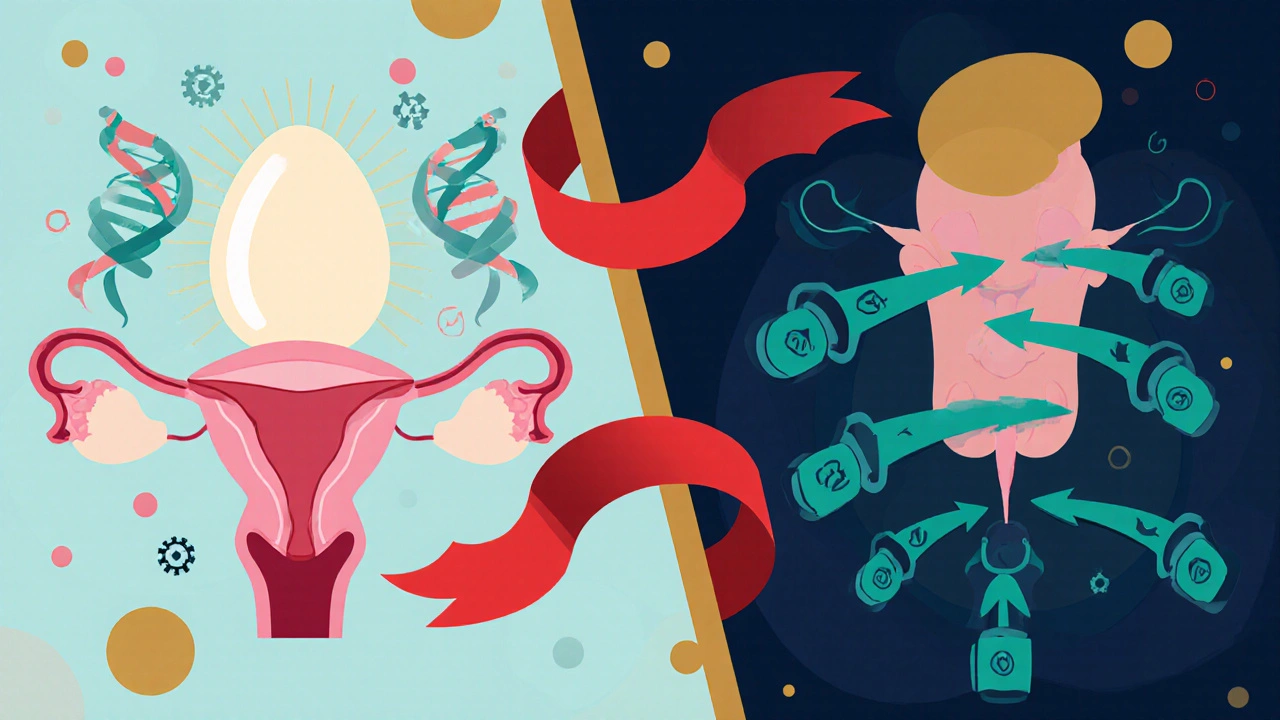Iron-Folic Acid Fertility Calculator
Preconception Supplement Calculator
Calculate when to start iron-folic acid supplements and recommended dosage for optimal fertility.
Couples trying to start a family often focus on diet, exercise, and timing, but one simple supplement can make a big difference: iron-folic acid. Understanding how this combo works, who should take it, and when to begin can boost both male and female reproductive health and set the stage for a healthy pregnancy.
What is Iron-Folic Acid?
When we talk about Iron-Folic Acid is a combined supplement that delivers two key nutrients-iron and folate-in a single pill. Iron supports oxygen transport in the blood, while folate (vitamin B9) is crucial for DNA synthesis and cell division. This pairing is most common in prenatal vitamins, but it also has a role well before pregnancy, especially for couples planning conception.
Why Fertility Matters - The Role of Iron and Folate
Both iron and folate influence the reproductive system in ways many people don’t realize.
- Folate helps the body create healthy eggs and sperm by supporting DNA replication. Low folate levels are linked to reduced ovarian reserve and poorer sperm quality.
- Iron is essential for producing hemoglobin, the protein that carries oxygen in red blood cells. Adequate oxygen delivery ensures the uterine lining thickens properly and that developing embryos receive enough oxygen from the start.
When either nutrient is lacking, the body can experience Anemia, a condition characterized by reduced hemoglobin and fatigue. Anemia can disturb ovulation cycles and lower sperm motility, directly affecting fertility.
Benefits for Women’s Reproductive Health
For women, the iron‑folic acid combo supports several fertility milestones:
- Egg Maturation: Folate fuels the rapid cell division that turns a primary oocyte into a mature egg. Studies show that women with adequate folate have higher rates of successful ovulation.
- Uterine Lining (Endometrium) Development: Iron‑rich blood supplies oxygen to the endometrium, helping it grow thick enough to nurture an implanted embryo.
- Reduced Risk of Early Pregnancy Loss: Low folate is associated with higher miscarriage rates. Supplementing early can cut that risk.
- Prevention of Neural Tube Defects (NTDs): While NTDs appear after conception, sufficient folate before pregnancy dramatically lowers the chance of conditions like spina bifida.
In a 2023 WHO review, women who started a daily iron‑folic acid supplement at least three months before trying to conceive had a 12% higher live‑birth rate compared with those who began after confirming pregnancy.
Benefits for Men’s Reproductive Health
Men often overlook nutrition when thinking about fertility, yet iron and folate matter for sperm too.
- Sperm Production: Folate is required for the formation of sperm DNA. Deficiencies can lead to fragmented DNA, which reduces fertilization potential.
- Sperm Motility: Iron deficiency anemia diminishes energy production in sperm cells, leading to slower swimming speeds.
- Hormonal Balance: Adequate iron helps maintain normal testosterone levels, which in turn supports libido and sperm output.
Research published in the *Journal of Male Reproduction* (2022) found that men taking a 400‑µg folic acid supplement for 12 weeks improved sperm count by 15% and motility by 9%.

How Much to Take? Dosage Guidelines
Dosage varies by gender and life stage. The following table summarizes the most commonly recommended amounts based on WHO and US Institute of Medicine guidelines.
| Group | Iron (mg) | Folate (µg DFE) | Typical Tablet Strength |
|---|---|---|---|
| Women of reproductive age (non‑pregnant) | 18 | 400 | 60mg iron+400µg folic acid |
| Men (18‑45y) | 8 | 400 | 30mg iron+400µg folic acid |
| Pregnant women (first trimester) | 27 | 600 | 60mg iron+400µg folic acid (often combined with additional iron later) |
For couples trying to conceive, the women's dosage (the first row) is the safe baseline. Men can use the lower‑iron version, which reduces gastrointestinal discomfort while still delivering enough folate.
Food Sources vs. Supplements
Whole foods are great, but meeting the exact numbers through diet alone can be tricky, especially for iron.
- Iron‑rich foods: Red meat, poultry, lentils, spinach, and fortified cereals. Heme iron from animal sources is absorbed about twice as well as non‑heme iron from plants.
- Folate‑rich foods: Dark leafy greens, citrus fruits, beans, and avocado. Cooking can destroy up to 50% of folate, so raw or lightly steamed options preserve more.
- Vitamin C boost: Pairing iron sources with vitamin C (e.g., orange juice with spinach) can increase iron absorption by up to 70%.
Even with a balanced diet, many couples fall short of the iron and folate targets, especially if they’re vegetarian or have high menstrual losses. That’s where a daily iron‑folic acid tablet fills the gap.
Timing - When to Start Before Trying to Conceive
Timing matters. Starting too late means the body hasn’t built up enough nutrient stores.
- Three‑Month Rule: Begin a daily iron‑folic acid supplement at least 90 days before you start trying. This period matches the lifespan of a mature egg and the time needed for spermatogenesis.
- Continuous Use: Keep taking the supplement through the first trimester, even after conception, to protect against anemia and support the embryo’s neural tube formation.
- Check Your Levels: If you have a history of anemia, get a blood test for hemoglobin and serum ferritin before you begin. Adjust dosage under a doctor’s guidance if needed.
Common Side Effects and How to Manage Them
Iron‑folic acid is safe for most adults, but a few people experience mild issues.
- Stomach Upset: Take the tablet with food or a small glass of orange juice.
- Constipation: Increase water intake, add fiber‑rich foods, or consider a gentle stool softener.
- Dark Stools: This is harmless and simply reflects iron passing through the digestive tract.
- Allergic Reactions: Rare, but stop the supplement and seek medical help if you notice rash, swelling, or breathing difficulty.
If side effects persist, talk to a healthcare provider. Sometimes a lower‑iron formula or splitting the dose (half in the morning, half at night) helps.
Quick Checklist for Couples
- Confirm both partners have a baseline iron‑folic acid supplement (women: 60mg iron+400µg folate; men: 30mg iron+400µg folate).
- Start at least three months before trying to conceive.
- Include vitamin C‑rich foods to boost iron absorption.
- Monitor for side effects; adjust timing with meals.
- Get a blood test for hemoglobin and ferritin if you have a history of anemia.
Frequently Asked Questions
Can men take the same iron‑folic acid supplement as women?
Men can use a lower‑iron version (around 30mg) combined with 400µg folic acid. This provides enough folate for sperm DNA while minimizing iron‑related stomach upset.
Do I need a prescription to get iron‑folic acid?
In the United States, over‑the‑counter iron‑folic acid tablets are widely available. Prescription strength (higher iron) is reserved for diagnosed anemia.
Will taking iron‑folic acid guarantee a pregnancy?
No. The supplement improves the odds by supporting healthy eggs, sperm, and uterine lining, but timing, overall health, and other factors still play major roles.
What if I’m already pregnant? Should I keep taking the same tablet?
Yes, continue the 400µg folic acid dose throughout the first trimester. Many doctors recommend increasing iron to 27mg later in pregnancy to meet rising blood volume needs.
Can I get enough iron and folate from food alone?
It’s possible with a carefully planned diet, but most couples find a supplement the simplest way to hit the exact numbers, especially when menstrual losses are high.
Bottom line: Adding an iron‑folic acid supplement to your pre‑conception routine is a low‑cost, evidence‑backed step that can boost fertility for both partners. Pair the pill with a balanced diet, keep an eye on any side effects, and start early-your future family will thank you.
